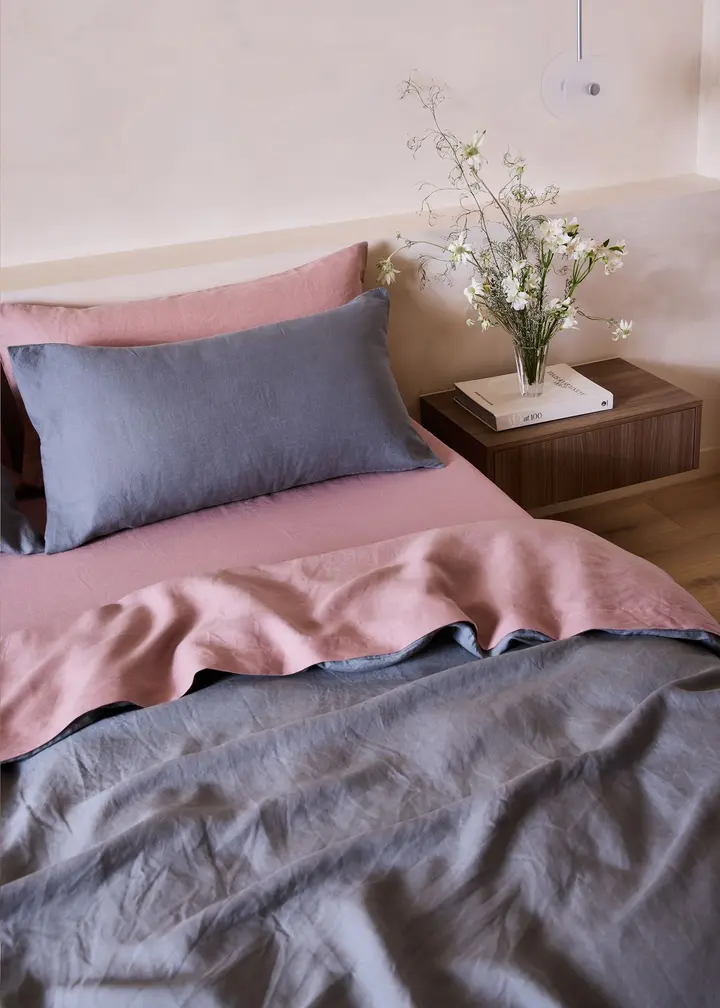
How to Get Sweat Stains Out of Pillowcases
You don't need to sweat it. This is how to remove stains from your pillowcases.
While it might not be the most glamorous topic of conversation, it's universally acknowledged that pillowcases can become stained and yellow over time. But why do they get grimy, where do these stains come from, and how can you keep your pillowcases cleaner for longer?
Turns out, it's pretty simple. Knowing how pillowcases get stained and – more importantly – a few easy ways to remove said stains, you can ensure your pillows stay fresh and clean. Not only will clean pillowcases be much more pleasant to sleep on, but they can also help your pillows stay cleaner for longer.
Where do yellow stains come from?
If you've noticed your white pillowcases slowly turning yellow over time, you’re not alone.
Yellowed pillowcases are a surprisingly common phenomenon caused by everything from moisture to hair products accumulating on your pillowcases over time.
While these types of stains may be most noticeable on white pillowcases, they can also appear on coloured pillowcases, with the stained area appearing slightly darker than the rest of the pillow.
There is no single thing that causes yellow stains, but rather a slew of stain types that may contribute to an overall yellowing or discolouration of your pillowcases.
Types of pillowcase stains
- Oil stains: While you may associate oil stains with the kitchen more than the bedroom, it's not uncommon for pillowcases to be stained by body oils, hair oils, and facial oils. It's normal for your body to produce oil (it keeps your skin supple and hair shiny), but over time a buildup of these grease stains can change the colour of pillowcases.
- Fake tan stains: Applying tan drops before bed may be a great way to wake up with a healthy glow, but fake tan is a common culprit of pillowcase stains. Unless you sleep soundly on your back throughout the night, the odds are that some of that self-tanner will end up on your pillowcase. Just like the fake tan gives your skin glowing warmth, it can also rub off and leave an orange, yellow or brown hue on your pillowcases.
- Stains from moisture: Believe it or not, moisture alone is enough to cause that yellow tint on your pillows. Going to bed with wet hair or unconscious drooling (no shame!) can lead to yellow stains over time.
- Beauty products: Moisturisers, serums, and masks can all rub off onto your pillow while you sleep, leading to discoloured, grimy pillowcases.
How to get rid of pillowcase stains
While it might be difficult to avoid stains on your linen altogether, the good news is that they are surprisingly easy to clean. In just a few simple steps, your yellow pillows will be transformed back into bright, white pillows in no time.
Washing Machine
Pillowcases can be washed alone in a washing machine or with the rest of your bedding as long as everything is made from the same material. For example, if you use linen pillowcases, washing them with linen bedding is okay, but throwing them in with different fabrics is a no-go.
When washing linen pillowcases in particular, follow these steps for the best results:
- Stain remover: To remove stains from pillowcases without damaging them, first sprinkle baking soda over the stained area. Next, add a small amount of lemon juice on top, then let the mixture sit for about fifteen minutes.
- Mild detergent: Follow the same principles for your pillowcases that you would for washing linen sheets. It is best to use a mild, liquid laundry detergent and a cycle with lots of water. Avoid anything with harsh chemicals, such as fabric softeners or intense all-purpose detergents. Err on the side of less detergent and more water to avoid unwanted residue from detergent buildup.
- Add vinegar: If your pillowcases are especially dirty, try using the vinegar laundry hack to freshen things up. Adding 1/2 to 1 cup of white vinegar to your laundry load will remove odours from natural fibres and work as a stain-lifting wonder on even the most stubborn spots.
- Gentle cycle: To prevent friction (which can lead to pilling and pulling in the wash), pillowcases and other bedding should be washed on a gentle cycle.
- Air dry: Finally, it is best to avoid the tumble dryer when it comes to pillowcases. Instead, hang them on a line or laundry rack and allow them to air dry.
Hand Washing
Hand washing is a great alternative when you'd rather not run the laundry machine or perhaps only want to wash a few pillowcases at a time.
For best results, follow these steps:
- Stain remover: Use the same cleaning solution you would before machine washing, by sprinkling baking soda over any stained areas. Then, apply lemon juice over the baking powder and let it sit for about fifteen minutes before washing the pillowcases.
- Cold water: Fill a tub or basin with cold water and a tiny amount of mild detergent. You'll be dunking your hands in the water to wash the pillowcases, so if you find it hard to withstand the cold, you can add a small amount of warm water, but avoid hot water as it can lead to shrinkage.
- Soak: Submerge and soak the pillowcases for about ten minutes. Occasionally, stick your hand in the water and swish the pillowcases around, but do not twist or wring them, as it can ruin the structure of the fibres and cause tearing.
- Rinse: The easiest way to rinse detergent out of pillowcases is to put them directly under the tap and run water over them until all detergent has been washed out. Again, do not twist or bunch up the pillowcases, as it might misshape them.
- Dry: Air dry your pillowcases by hanging them on a laundry rack or line.
How to keep pillowcases clean
The best way to avoid grimy pillowcases is to have a few back-up sets so that you have clean options on rotation at all times.
Clean pillowcases
It is best to swap out dirty pillowcases for fresh ones at least once a week.
If you use any intensive beauty products while sleeping, such as hair masks, face masks, or self-tanner, you may want to change your pillowcase even more frequently.
Having a few extra pillowcases on hand is also helpful for those who sweat excessively, go to bed with wet hair, or drool in their sleep.
The longer you leave stains on pillowcases, the more difficult they become to remove, so it's best to try and swap out dirty pillowcases for clean ones as soon as possible.
Wash pillows regularly
In addition to keeping your pillowcases clean, it's also important to wash your pillows regularly.
Like pillowcases, pillows can absorb bodily oils and moisture, leading to stains on the actual pillow over time. Regular pillow washing helps prevent these stains from also staining your pillowcases.
Before washing your pillows, make sure to read the care labels carefully. While some pillows can be washed in the laundry machine, certain types require more care. Down pillows and memory foam pillows in particular may have special washing instructions that must be followed to avoid damaging the pillow.
Keep pillows clean with a pillow protector
If you still feel like you can't keep your pillows clean, you may want to consider using a pillow cover or pillow protector.
Like a pillowcase, pillow protectors (sometimes called pillow covers) slide over the pillow and can easily be removed and washed periodically.
Layered between the pillow case and the pillow itself, pillow protectors provide an additional barrier to stop dust mites, products, and stains from penetrating through to the actual pillow.
Typically, pillow protectors are washed on the same schedule as pillowcases, which keeps them fresh – and keeps your pillow from getting dirty in the first place!
Add a Fresh Pillowcase to Your Rotation
Enjoyed This?
Discover more cleaning content.














